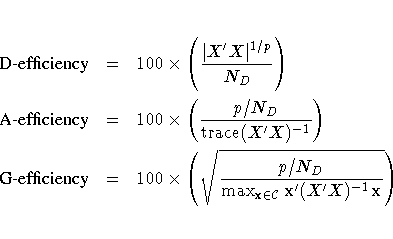Chapter Contents
Previous
Next
|
Chapter Contents |
Previous |
Next |
| Details of the OPTEX Procedure |
By default, the OPTEX procedure calculates the following efficiency measures for each design found in its search for an optimum design:

When you specify a BLOCKS statement, the D- and A-efficiencies for the treatment part of the model are calculated. These are calculated similarly to the preceding efficiencies, except that they are based on the information matrix after correcting for covariate effects. This matrix can be written as X'AX for a symmetric, positive definite matrix A that depends on the model for the covariate effect. If you specify a block structure or a covariate model, then A=I - Z(Z'Z)-1Z', where Z is the design matrix for the block or covariate effect. Alternatively, you can use the COVAR= option to specify the matrix A directly. Given A, the efficiencies in the presence of covariates are defined as follows:

Because these efficiencies measure the goodness of the design relative to theoretical designs that may be far from possible in many cases, they are typically not useful as absolute measures of design goodness. Instead, efficiency measures should be used relatively, to compare one design to another for the same situation.
For the distance-based criteria, there are no simple measures of design efficiency that can be scaled from 0 to 100. See the "Output" section for a definition of the design measures tabulated for these criteria.
|
Chapter Contents |
Previous |
Next |
Top |
Copyright © 1999 by SAS Institute Inc., Cary, NC, USA. All rights reserved.